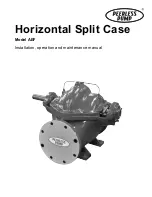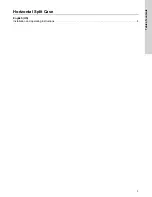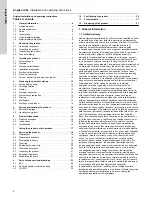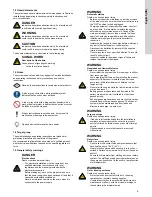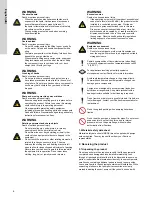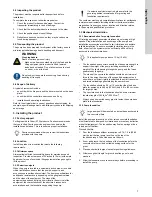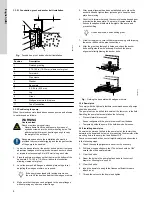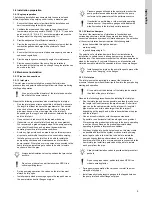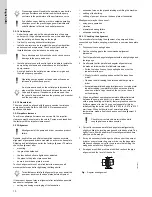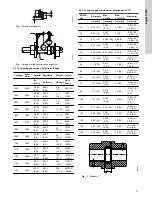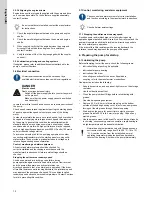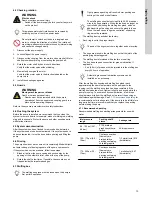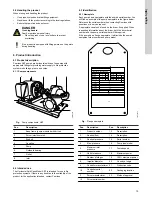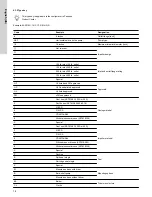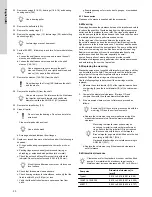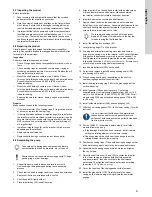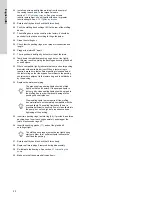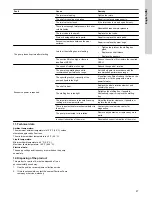
4.8 Starting up the product
4.8.1 Starting the pump
1.
Open the inlet valve completely, and close the outlet valve
completely.
2.
Switch the power supply on.
3.
Start the pump.
4.
Immediately make a visual check of the pump and inlet pipe.
5.
Allow the pump to ramp up to full speed.
6.
Slowly open the outlet valve until the operational flow is
achieved.
7.
Check the outlet pipe for leaks.
8.
Open the isolating valves for the pressure gauges.
9.
Record the pressure readings.
10. Verify that the pump performance is within the tolerance of the
pump performance curve.
4.8.1.1 Air in the system
Entrained air reduces pump total head and flow rate.
Use an eccentric reducer on the inlet pipe.
Return lines into tanks should terminate a minimum of two
pipe diameters below the low liquid level.
4.8.1.2 Checking the driver lubrication
Before running the drivers either separately or connected to the
pump:
1.
Follow the driver manufacturer instructions for lubrication
requirements.
2.
Ensure that the grease-lubricated bearings in the driver have
been properly greased with the grade of grease recommended
by the driver manufacturer.
4.8.1.3 Driver settings
Refer to the manufacturer's instructions.
4.8.1.4 Pump performance
Initial field test data becomes a valuable baseline for
future troubleshooting and maintenance. It may not be
possible to match the factory performance due to
differences in system resistance.
Once the pump is operating, verify the following:
1.
The pipe connections are tight, and no leaks are present.
2.
The following attributes match the pump nameplate:
a. operating speed
b. flow rate
c. inlet and outlet pressure
d. power input, P1.
5. Storing and handling the product
5.1 Short-term storage
Standard factory packaging is suitable for protection during
shipment and during covered storage at a job site for a short period
between installation and startup. The preservatives applied at the
factory have an effective life of two to three months from the date of
shipment from the factory, depending on the severity of the
environment in which the equipment is exposed. For international
destinations, this will vary depending on the seaworthiness of
export boxing.
5.1.1 Controlled storage
Storage facilities should be maintained at an even temperature with
a relative humidity lower than 50%, and little or no dust. Inspect
and recoat the equipment periodically with water displacement rust
inhibitor, vapor phase inhibitor, or rust preventive coating.The
equipment must be inspected weekly to ensure that all
preservatives are intact, and internals are protected.
5.1.2 Uncontrolled storage
For uncontrolled storage periods of three months or less, inspect
the equipment weekly to ensure preservatives are intact and
internal parts are protected.
Preparing the product for uncontrolled storage
•
Periodically inspect and recoat the equipment with rust and
vapor phase corrosion inhibitors.
•
Seal all pipe threads and flanged pipe covers with tape. Place
an adequate amount of desiccant near the center of the pump.
•
If the pump is assembled, place and securely fasten
additional desiccant in the outlet of the pump.
•
Cover the equipment with black polyethylene or equivalent,
with a minimum thickness of 0.006 in (0.15 mm).
•
Provide a ventilation hole approximately the size of a small
coin.
•
Provide protection from direct exposure to the environment.
•
If applicable, connect space heaters on equipment such
as motors, engines or controls.
5.1.3 Short-term storage
•
The pump and equipment, as shipped, have adequate
protection for short-term storage for up to three months.
•
If the product is not to be installed and operated immediately
after receiving it, store it in a clean, dry area at a moderate
ambient temperature.
•
For packed-type pumps, the packing glands may be left on the
pump shaft and securely fastened in position. All exposed
machined surfaces should be thoroughly coated with a film of
rust preventative material.
•
For packed-type pumps, the stuffing box packing must be
removed and stored in a sealed plastic bag. Seal the end of the
stuffing box with rolled vapor phase inhibitor paper and seal
with weatherproof tape.
•
Rotate the shaft by hand periodically, at least monthly, to coat
the bearing with a lubricant to retard oxidation and corrosion.
•
Make sure the pump cannot roll or fall over.
•
Follow the motor manufacturer's storage recommendations
where applicable.
5.1.4 Long-term storage
•
Long-term storage protection provided by the factory does not
extend the warranty in any manner.
•
The warranty is valid only if the equipment is properly handled
and stored.
•
In case of storage up to six months or longer, the pump must
be protected against heat and moisture as described in the
previous sections.
•
Periodically, at least monthly, manually rotate the shaft to coat
the bearing with a lubricant to retard oxidation and corrosion.
•
Ensure that the pump cannot roll or fall over.
•
Follow the motor manufacturer's storage recommendations
where applicable.
•
Inspect the pump before putting it into operation. Make sure
that the impeller can rotate freely. Pay special attention to the
condition of the shaft seals or the packing and O-rings.
5.1.5 Accessories storage
Store accessories according to the manufacturer's instructions.
14
English (US)

